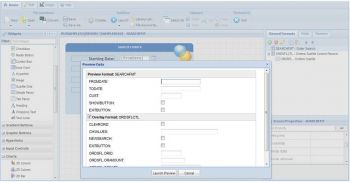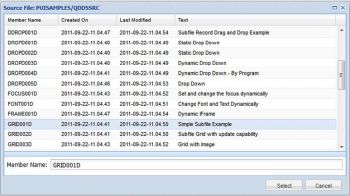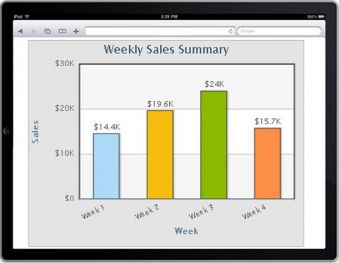New release of the IBM i application modernization suite includes PHP support and skins for iPad HD.
Profound Logic Software has released V4 of Profound UI, its modernization and user interface platform for IBM i. Profound UI was first introduced in 2010 alongside the announcement of Rational Open Access for RPG by IBM. It was the first handler for Open Access and offered a comprehensive set of tools for building Web and mobile applications as well as modernizing green-screen applications at either the 5250 or the DDS source code level. The company has been very active in improving the offering based on customer feedback and has managed to publish more than a thousand enhancements to the software since the original debut in 2010.
With the announcement of V4, many important features are being introduced. Profound UI 4.0 includes new capabilities, such as:
• Sharing UI definitions between different file systems
• Deploying applications through many other programming languages and server platforms in addition to RPG on the IBM i
• Rapidly building “what-if” scenarios through a new Application Preview feature
• The ability to explore source members, IFS files, and reference tables through a set of new dialogs provided in the Profound UI Visual Designer
• Enhancements to existing widgets, conversion themes, and refacing skins (for example, the menu widget now offers the ability to present submenus and pull-down menus, while the chart widgets are now HTML5-capable, which provides for seamless rendering on mobile devices)
• Several new skins for 5250 modernization, including a skin for the new iPad 3 device
Running Profound UI on other platforms
Profound UI 4.0 now boasts a new capability to Open and Save user interface definitions to the IFS or to the developer’s local drive, in addition to traditional source members. This allows UI components to be published and shared easily or even emailed as standard files to other developers. The UI can be saved in either DDS format compatible with Open Access for RPG or as JSON files, which are platform independent.
Furthermore, the new capability is supplemented with powerful API to enable rich display file screens to be presented from any language on any server. This is accomplished by feeding data into the screens through a server-side page or through JavaScript. The user's response is provided back as POST data to the server or through a JavaScript handler function. Profound UI allows rich displays to be embedded into a Web page using <script> tags or retrieved dynamically through the use of AJAX. All of this is in addition to being able to compile the UI into display file objects to be utilized by RPG code through Rational Open Access.
“Our Web 2.0 platform has really evolved and become very robust and easy to use over past two years. When working with customers, we saw that even non-RPG developers are starting to notice and even envy our UI platform,” says Alex Roytman, CEO at Profound Logic. “Now, they will be able to use it. While we still believe that RPG Open Access and the Profound UI Handler are superb ways to build applications, having the ability to use the same user interface to build applications outside of RPG provides flexibility.”
Profound UI developers now have more options. They can deploy Profound UI rich displays from PHP, for example. PHP, a language that has traditionally been utilized with HTML, can now have a 100 percent Web 2.0 interface. This provides many benefits to PHP developers, some of which are outlined below:
• Inherent Validation
o Data type validation (i.e. enforce the user to enter data as it is defined before anything is submitted to the server—numeric versus character, maximum length and decimal positions, date formatted a specific way, etc. )
o Many built-in client-side validation options (ranges, comparisons, required fields, etc.)
o Simple ways to trigger and display server-side validation messages
• Effortless implementation of features such as:
o Drag and drop
o Pop-up windows and dialogs
o Cursor positioning
o Database-driven auto-complete
o Automatic population of components such as drop-downs from a database
• Use of advanced widgets like:
o Panels
o Pop-up calendars
o Combos
o Tabs
o Spinners
o Sliders
o Charts
o Menus
• Advanced data listing/grid component options:
o Automatic client-side sorting
o Movable columns
o Row selection
o Context menus
o Paging bar
o Built-in export to Excel
o Expanding rows
o Single-row zoom
These types of details typically take many hours of custom development work using traditional Web programming. However, when utilizing Profound UI, all of the above can be configured quickly using the Profound UI Visual Designer, without custom programming.
Profound UI is specifically made for transactional business applications. One of its major advantages is the ability to treat Web screens like data sets or record formats. This means that a PHP developer can fetch a record of data and, using one line of code, output that data to a Web screen defined in Profound UI. This saves a lot of time and keeps PHP code tidy.
Similar to PHP, rich displays can now be used within CGI programs through tools like CGIDEV2 or Profound Logic’s RPGsp. They can also be utilized in mobile deployment scenarios where the application may need to present screens while in an offline state.
Profound UI 4.0 also ships directives to allow companies to run Open Access programs, PHP scripts, and CGI programs from the same Apache instance.
Application Preview
The new Application Preview feature in Profound UI allows developers to prototype and test applications much faster than before. The new functionality is tied into the browser-based Visual Designer tool, which can launch the preview in a separate tab of the browser. Any designer changes are automatically reflected in the preview when the preview tab is refreshed.
With this feature, screen functionality can be tested without having to write any RPG code or deploying anything to the server. This is achieved by prompting the developer for all necessary dynamic data elements in order to simulate the screen. All widgets, including subfile grids will render in the preview as they would at runtime. Developers can set up various “what-if” scenarios to test any combination of RPG indicators or data values. Developers can even choose to overlay several screens together. See Figure 1.

“There is definitely a lot of value in being able to test screens quickly when you develop. It will be helpful in our own development and customer support efforts as well,” May said.
Member, IFS File, and Reference Table Browsing
To further simplify application development, a new set of lookup tools have been added to the Visual Designer in V4. When working with source in Profound UI, developers now have the convenience of being able to explore which files and directories are available on the IFS file system. Similarly, developers can browse the library file system for DDS source members when opening, saving, or converting display files. See Figure 2.

Menus
The Menu Widget has undergone a number of enhancements in this release. Menus can now have unlimited levels of submenus. They can also be presented as context menus or as pull-down menus thanks to the new “context menu ID” and “orientation” properties that are now available.
Even more significant is the ability to map traditional green-screen function keys to menu options. This can be tied into a DDS conversion theme to facilitate automatic creation of menus based on existing DDS function keys and the RPG code that controls them.
Charts
A new set of HTML5-based charts is included in this release of Profound UI. Prior to V4, charts were rendered as Flash objects. Now, Profound UI can utilize either Flash or HTML5. With HTML5, charts can be easily rendered on devices that may not support Flash, such as the iPad or the iPhone.

The new charts also offer a number of additional capabilities, such as new chart types, advanced drill-down features, and more supported data formats. Profound UI charts can consume data using JSON, XML, comma separated values, or directly from a DB2 database. See Figure 3.
New Skins and Themes
Also new in V4 are iPad-specific skins for the Genie 5250 refacing module. This includes a skin for the new third generation iPad HD. The skins provide a built-in keypad to make it easy to utilize special 5250 keys on the device.
“We are continuing to see an increase in mobile deployment,” comments David Russo, project manager at Profound Logic. “These new skins allow customers to publish 5250 apps to an iPad device with virtually zero setup or configuration.”
Profound Logic is also packaging a new DDS conversion theme made specifically for mixed-state environments where customers are deploying 5250 refaced, converted, and new programs within one application. The new “Hybrid” theme ensures a consistent look and feel across all deployed components.












 Business users want new applications now. Market and regulatory pressures require faster application updates and delivery into production. Your IBM i developers may be approaching retirement, and you see no sure way to fill their positions with experienced developers. In addition, you may be caught between maintaining your existing applications and the uncertainty of moving to something new.
Business users want new applications now. Market and regulatory pressures require faster application updates and delivery into production. Your IBM i developers may be approaching retirement, and you see no sure way to fill their positions with experienced developers. In addition, you may be caught between maintaining your existing applications and the uncertainty of moving to something new. IT managers hoping to find new IBM i talent are discovering that the pool of experienced RPG programmers and operators or administrators with intimate knowledge of the operating system and the applications that run on it is small. This begs the question: How will you manage the platform that supports such a big part of your business? This guide offers strategies and software suggestions to help you plan IT staffing and resources and smooth the transition after your AS/400 talent retires. Read on to learn:
IT managers hoping to find new IBM i talent are discovering that the pool of experienced RPG programmers and operators or administrators with intimate knowledge of the operating system and the applications that run on it is small. This begs the question: How will you manage the platform that supports such a big part of your business? This guide offers strategies and software suggestions to help you plan IT staffing and resources and smooth the transition after your AS/400 talent retires. Read on to learn:
LATEST COMMENTS
MC Press Online